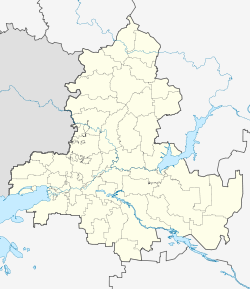Bataisk
| city
Bataisk
Батайск
|
||||||||||||||||||||||||||||||||||||||||||
|
||||||||||||||||||||||||||||||||||||||||||
|
||||||||||||||||||||||||||||||||||||||||||
| List of cities in Russia | ||||||||||||||||||||||||||||||||||||||||||
Bataisk ( Russian Бата́йск ) is a major Russian city with 111,843 inhabitants (as of October 14, 2010) in the Rostov Oblast , about ten kilometers south of the metropolis of Rostov-on-Don on the opposite bank of the Don .
history
The city was built in 1769 as a base to protect the important port of Azov on the Don estuary into the Sea of Azov against attacks by the Crimean Khanate . Before the Russo-Turkish War of 1768–74, the area around today's city belonged to the Ottoman Empire . At that time there was a Tatar base called Batai , from which the current city name comes from.
In the 19th century, Bataisk lost its military importance and developed mainly thanks to the road running in its vicinity between the Russian heartland and the Kuban region. In addition, the railway line leading into the North Caucasus was moved through Bataisk in 1875 .
In the 1920s, the place was electrified across the board, which enabled the establishment of the first industrial operations - including a bread factory. In 1927 the place was given the status of a workers' settlement, and in 1938, when almost 50,000 inhabitants lived there, it was granted city rights. In 1931, a military aviation school was founded in Bataisk, whose well-known students later included the cosmonaut Vladimir Komarov .
In July 1942 fierce fighting took place in Bataisk between the Red Army and the German Wehrmacht , which had built a bridgehead over the Don near Rostov. From here it advanced towards the Caucasus, but had to vacate the city again after the defeat of Stalingrad in 1943. In total, around 3,500 of its residents were killed during the fighting for the city. After the war, however, the city's infrastructure was quickly restored and further expanded in the 1950s and 1960s.
Population development
| year | Residents | comment |
|---|---|---|
| 1939 | 49,614 | and 13,659 Koissug (incorporated in 1959) |
| 1959 | 65,158 | |
| 1970 | 85,306 | |
| 1979 | 90.123 | |
| 1989 | 91,930 | |
| 2002 | 107,438 | |
| 2010 | 111,843 |
Note: census data
Economy and Transport
The city's industry is mainly geared towards the needs of the neighboring metropolis Rostov. These include food and textile factories as well as companies in the building materials and reinforced concrete industries.
The city is connected to the M4 trunk road and is also a railway junction. Here it is particularly important for freight transport.
sons and daughters of the town
- Tatjana Lyssenko (* 1983), hammer thrower
Individual evidence
- ↑ a b Itogi Vserossijskoj perepisi naselenija 2010 goda. Tom 1. Čislennostʹ i razmeščenie naselenija (Results of the All-Russian Census 2010. Volume 1. Number and distribution of the population). Tables 5 , pp. 12-209; 11 , pp. 312–979 (download from the website of the Federal Service for State Statistics of the Russian Federation)
Web links
- Official website of the city administration (Russian)
- Site of the local newspaper «Вперёд» (Russian)
- City information portal (Russian)
- Bataisk on mojgorod.ru (Russian)




